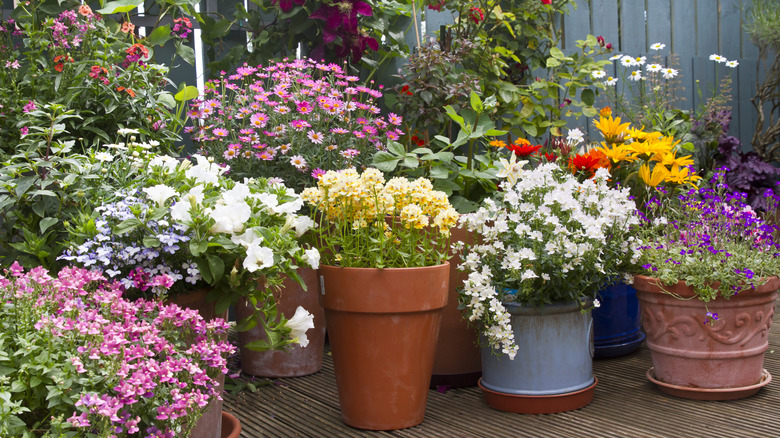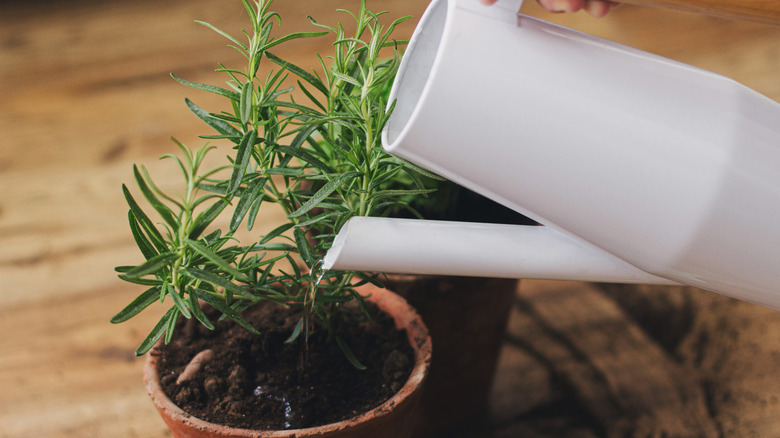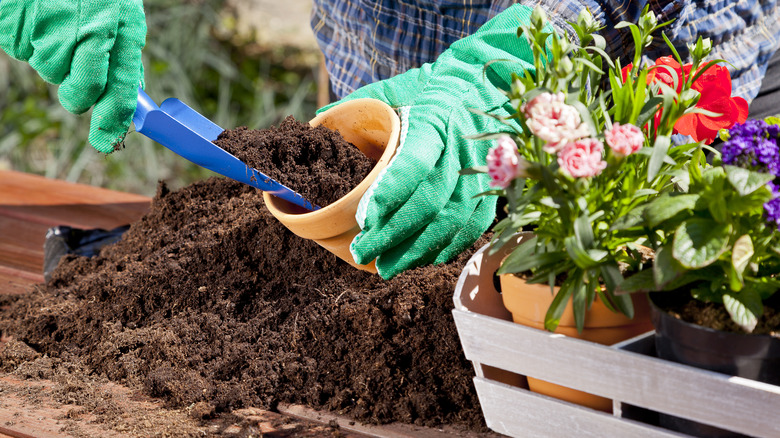The Biggest Problem With Container Gardening You Should Watch For
Considering 2023 was the hottest year on record, we can't help but wonder if upcoming summers are going to be more of the same. While many plants thrive in warm temperatures, they must receive the proper amount of water regularly. Plants in the garden rely on rainfall, supplemented by irrigation from your hose or sprinkler. We have plenty of tips on the best ways to water your plants in the soil and in any decorative containers you may have.
But about those containers, it's important to understand that the type of container your plant is living in affects the amount of water that's getting to roots. Terra cotta and clay pots are porous, so they tend to absorb water. Plain plastic pots tend to wick moisture away from their surfaces, meaning that water from rainfall or the garden hose ends up nurturing the plant, not seeping into the pot. Also, containers should be larger rather than smaller to help keep the water more available to the plants over time, since water in smaller containers simply drains (or should) without saturating the pot's soil.
Water, but not too much
As convenient as container gardens are, just be aware the entire container tends to dry out much faster than gardens planted in the ground. Potting soil or potting mix tends to be lighter and less dense than regular soil in the garden, and the organic materials in the potting mix simply don't hold water as well as garden soil. The solution is to water the containers more frequently, possibly twice daily, especially if you are experiencing a heat wave.
Once you're sure your plants are getting enough water, the other thing to watch for with container gardening is the runoff. No matter what your container is made from, be sure it has a hole in the bottom for drainage. Healthy plants need water on their roots, and drainage ensures the water has a place to go. Plants sitting in saturated soil with no drainage leads to root rot, which eventually can kill the plant. If you're concerned about water dripping onto the patio or your floor, just put a saucer under your pot to catch the excess. If you are watering from the top down, experts indicate you can toss the extra water in the saucer after about ten minutes. However, there's also a method of watering from the bottom up that allows a plant to absorb water from below.
Preventive measures
How can you tell if your potted plant needs more water? While water meters are available at garden shops, just testing the soil with your finger works well. Simply press your fingertip into the soil. If soil specks cling to your finger, you don't need to water. If the soil is just starting to feel dry, it's time to water again. The soil for a potted plant should always be loose and easy to move.
There are several solutions to ensure it's the plants getting the water and not the pot. If you love the look of terra cotta and clay pots, you can paint a coating onto the interior of the pot before planting using a clay pot sealer available at Michaels or look for tile and stone sealer at DIY retail outlets. There are both water-based and oil-based sealants that can be brushed or sprayed onto the interior, even the exterior if you like the color enough. Be sure to apply any sealant in a well-ventilated area and allow it to dry thoroughly before adding the soil and the plant. Even if you coat the interior with a sealant, another way to retain as much water as possible is mulching. Add a layer of organic material such as wood chips, straw, or pine needles to protect your plants.


